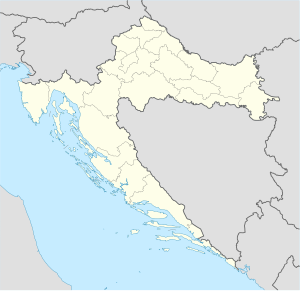1991 protest in Split
| 1991 protest in Split | |||
|---|---|---|---|
| Part of the Croatian War of Independence | |||
|
Location map of Split in Croatia
|
|||
| Date | 6 May 1991 | ||
| Location |
Split, Croatia 43°30′13″N 16°25′43″E / 43.503511°N 16.428529°ECoordinates: 43°30′13″N 16°25′43″E / 43.503511°N 16.428529°E |
||
| Caused by | Yugoslav People's Army blockade of Kijevo | ||
| Goals | Lifting of the blockade | ||
| Methods | Street protest | ||
| Resulted in | No direct results | ||
| Parties to the civil conflict | |||
|
|
|||
| Number | |||
|
|||
| Casualties | |||
|
|||
The 1991 protest in Split was a street protest against the Yugoslav People's Army (Jugoslovenska Narodna Armija – JNA) held in Split, Croatia on 6 May 1991. The protest was organised by the Croatian Trade Union Association in the Brodosplit Shipyard and joined in by workers from other companies in the city and other residents of Split after radio broadcast appeals for help while the protesters marched through the streets. Ultimately, the protest drew 100,000 supporters.
The march ended in a picket in front of the Banovina building, where the JNA had its headquarters in Split at the time. The protesters demanded an end to the JNA-imposed blockade of the village of Kijevo. Scuffles broke out in front of the building, and a JNA soldier was killed by a gunshot reportedly fired from the crowd. Four organisers of the protest were arrested a month later by the JNA, tried in a military court and convicted. They were released months later in a prisoner exchange. The protest caused the JNA to withdraw a portion of military equipment previously based in Split to more secure locations and increase its combat readiness there. The blockade of Kijevo was lifted through negotiations days after the protest.
In 1990, following the electoral defeat of the government of the Socialist Republic of Croatia, ethnic tensions worsened. The Yugoslav People's Army (Jugoslovenska Narodna Armija – JNA) then confiscated the weapons of Croatia's Territorial Defence (Teritorijalna obrana) in order to minimize resistance. On 17 August, tensions escalated into an open revolt of the Croatian Serbs, centred on the predominantly Serb-populated areas of the Dalmatian hinterland around Knin, parts of the Lika, Kordun, Banovina and eastern Croatia. After two unsuccessful attempts by Serbia, supported by Montenegro and Serbia's provinces of Vojvodina and Kosovo to obtain the Yugoslav Presidency's approval to deploy the JNA to disarm Croatian security forces in January 1991, and a bloodless skirmish between Serb insurgents and Croatian special police in March, the JNA itself, supported by Serbia and its allies, asked the federal Presidency to grant it wartime powers and declare a state of emergency. The request was denied on 15 March, and the JNA came under the control of Serbian President Slobodan Milošević. Milošević, preferring a campaign to expand Serbia rather than the preservation of Yugoslavia, publicly threatened to replace the JNA with a Serbian army and declared that he no longer recognized the authority of the federal Presidency. The threat caused the JNA to gradually abandon plans to preserve Yugoslavia in favour of expanding Serbia. By the end of the month, the conflict had escalated to its first fatalities. The JNA intervened on the side of the insurgents, and prevented the Croatian police from taking action. In early April, the leaders of the Serb revolt in Croatia declared their intent to integrate the area under their control, viewed by the Government of Croatia as a breakaway region, with Serbia.
...
Wikipedia

